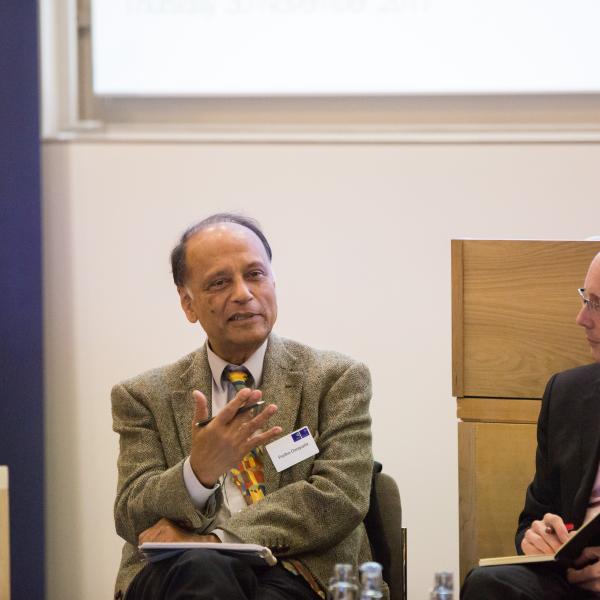About the event
How many people can Earth support in comfort? The problems of population and resources, prompts many further questions and contradictions.
The father–daughter duo Professor Sir Partha Dasgupta and Dr Aisha Dasgupta joined economist Andrew Dilnot for a Responsible Leadership Seminar on 30 November 2017.
The best of times and the worst of times
Sir Partha observed that the period of his own lifetime has been ‘very interesting for the average person on the planet.’
In 1950 life expectancy at birth for the average person was 45 years; now it is a little over 75 years. The average per capita income at today’s prices was $3000 per annum; today it is $15000. However, the global population then was 2.5 billion. Today it is 7.4 billion, pushing 7.5 billion.
‘We’ve never had it so good. We have mastered the earth, and mastered our own fate. So in some sense it is the best of times,’ he said. ‘If God gave you the option of being dropped on earth at any time, you would be very silly not to pick now.’
On the other hand, he described a paper published last year in Science by a group of leading earth scientists. They had tracked 11 geochemical signatures, including increased phosphorus and nitrogen deposits in the Greenland ice. The graphs for each had a distinctive ‘hockey stick shape’, with the turning point at about 1950. This, they argued, indicated the beginning of a new epoch, the Anthropocene, in which humanity has caused widespread changes to the Earth system that will potentially intensify in the future. ‘In many of these signatures we can’t shut off the damage,’ said Sir Partha. ‘Even if carbon emissions were to drop to zero today, there is still the momentum of the past. So in some ways we are also in the worst of times.’
Are we doing so well at the expense of the future for our children and our grandchildren, he asked. And what measures do we need to look at? The impact of our activities on the earth’s system depends on overall numbers as well as on the average impact.
Understanding the contradictions of reproductive rights
Dr Aisha Dasgupta is a demographer who works with reproductive health. She explained how very careful people in the field were to respect the reproductive rights of individuals. Women and couples should be able to choose when to have children and how many children to have.
‘There have been some ugly episodes in the history of family planning, with coercion and examples of forced sterilisation,’ she said. ‘The community has dedicated itself to never letting that happen again.’
However, she pointed out that there was a contradiction involved in recognising the rights of individuals to choose how many children they have, while at the same time recognising the rights of those who may suffer a negative impact from those additional births. ‘Does one set of rights trump the interests of all others around them?’
Another thing to consider is that family planning brings all manner of benefits to the individual users of contraception – benefits in terms of education, health outcomes, and gender equality for example. And it brings benefits to others as well, far beyond the individual.
How to define ‘comfortably’
Sir Partha explained that simply asking how many people the earth can support is not a good question. We need to consider both the impact on the biosphere, consumption, and standard of living.
He envisaged the biosphere as ‘a gigantic factory churning out stuff all the time’. It is partially a renewable resource, ‘but if you take more out than it can produce then of course you are depleting the stock.’
At the same time, he looked to the literature on happiness and wellbeing to suggest a suitable standard of living. Research found that incomes above about 20,000 international dollars in 2015 were not significantly correlated with increased happiness.
So the number of people he suggested the earth could comfortably support was 3.5 billion – which is less than half of what it is now. ‘This is not an answer,’ he stressed, ‘but a way to concentrate attention on the question.’
He pointed out that this is what the global population was in about the 1960s, so not that long ago. And that if we felt people could be content with an average income of $10 000 then we could support a population of 7 billion.
Other issues to consider
The total fertility rate in Africa today is still around five, meaning that women on average are having five children across their lifetime. This is much higher than in other parts of the world.
Aisha pointed out that conformity contributes to family planning issues. One woman’s preferences about family size are likely to be influenced by others in the community. There may have been reasons in parts of Africa for having had large families in the past. Communities could get into the practice of having large numbers of children, even if the reasons for that practice no long exist.
Norms can be very ‘sticky’, she said. But why has that kind of stickiness been broken down in Asia, Europe, and other parts of the world?
It might be possible to introduce a ‘nudge’ to make family planning programmes more collective. If a group of women in the same village were talking to each other they could be more informed about the intentions of the others. In addition, the role of the media can be very powerful in creating a broader reference community.
Other challenges include inequality and over-consumption, but Sir Partha was adamant that ‘the real problem is the total impact we could have on the biosphere. How that impact is apportioned is a gigantic problem for us all to think about. It lies in mesh of issues connected with distribution, population, intergenerational distribution, and consumption.’

